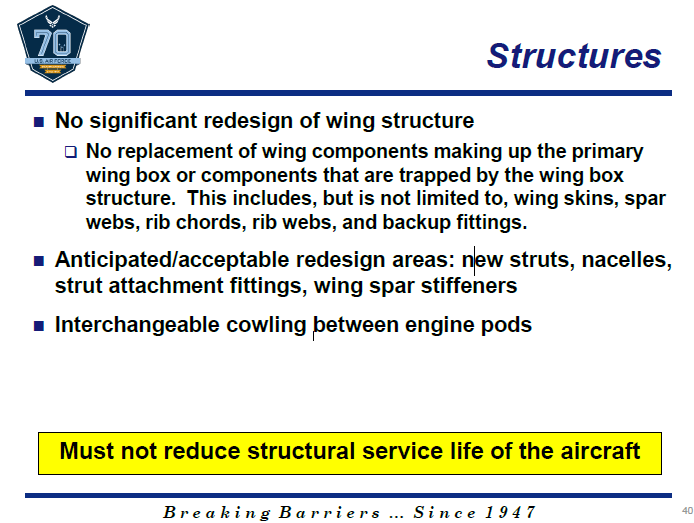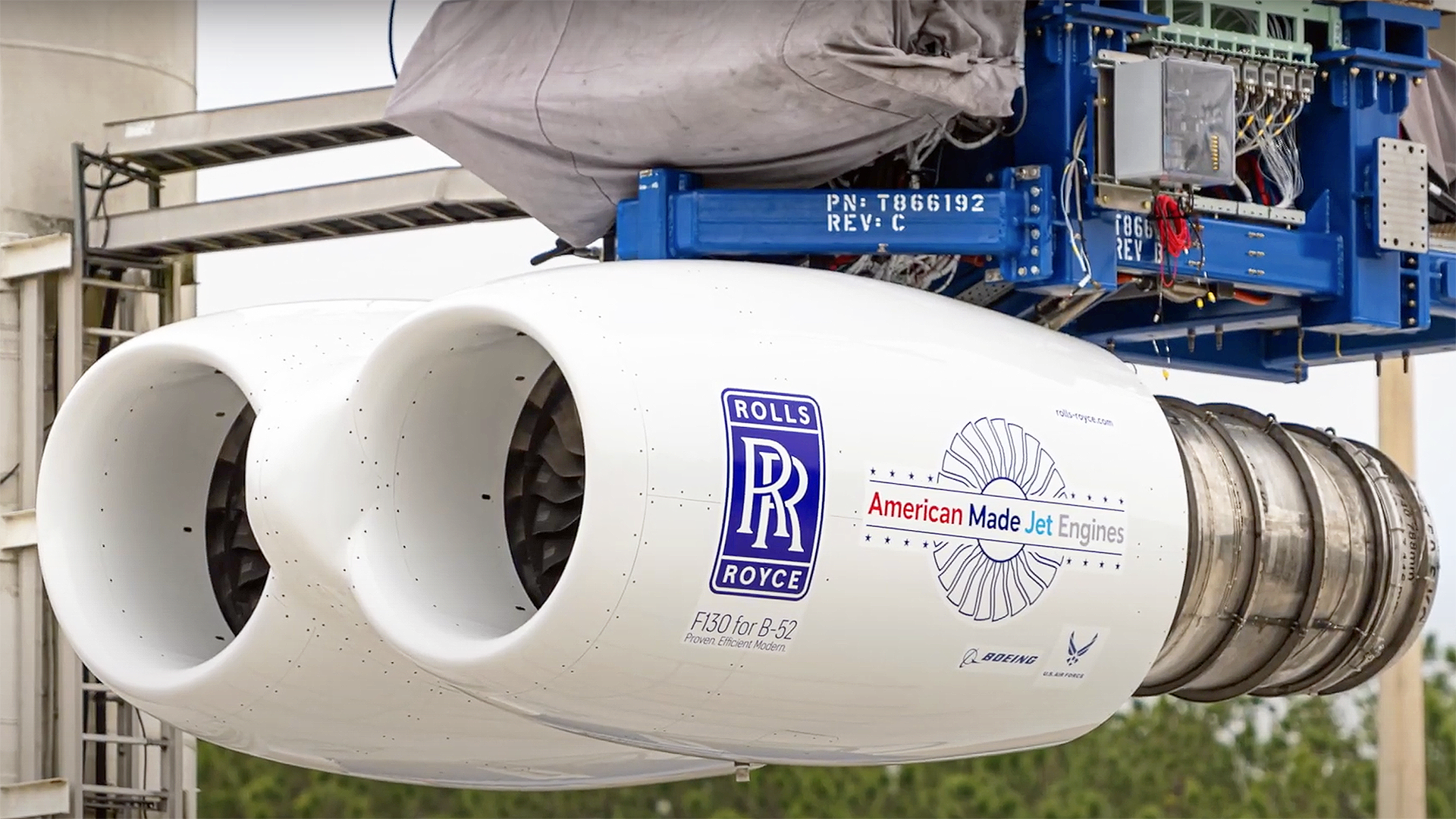Now that testing has begun, Rolls-Royce has provided first looks at the F130 turbofan engines in their dual-pod configuration that will replace the outdated TF33 engines currently equipping the U.S. Air Force’s B-52H Stratofortress fleet. Rolls-Royce has offered this imagery as part of an update on the years-long effort to re-engine and modernize the service’s bombers. In fact, the fight to get the B-52 new engines is a saga that dates back decades.
A Rolls-Royce press release explains that testing of the F130 engines under the Air Force’s B-52 Commercial Engine Replacement Program (CERP) is being carried out at the company’s outdoor test facility at NASA’s Stennis Space Center in Mississippi. The current round of testing will focus primarily on both crosswind aerodynamic flow and confirming that the engine’s digital controls system can operate as intended.
The evaluations also mark the first time that the F130 engines have been tested in a dual-pod configuration. This is central to the B-52 modernization plan, which will see those bombers’ eight current engines, also in twin-pod arrangements, replaced with an equal number of F130s. In other words, four engine pods that are each comprised of two nacelles will house eight F130s in total.
Boeing, the prime contractor for the B-52, is overseeing the engine integration and the aircraft’s overall modernization program. Rolls-Royce claims that early results from initial tests have been “very positive” and that additional test data gathered as the program moves forward will be analyzed over the next several months. The engines will eventually be manufactured at Rolls-Royce’s largest U.S.-based production facility located in Indianapolis.

“We are excited to begin this milestone testing program, the first step for what will be decades of successful engine operation for the U.S. Air Force B-52 fleet,” said Candice Bineyard, director of defense programs at Rolls-Royce. “Rolls-Royce continues to work very closely with the Air Force and Boeing to ensure the engine testing and integration process run smoothly. This will result in higher fuel efficiency, reduced air refueling requirements, and significantly lower maintenance costs for the B-52 fleet.”
Rolls-Royce’s F130 engine evaluations come after wind tunnel testing that was completed by Boeing in September of last year using a 4 percent model of a re-engined B-52. The company released a corresponding video, which can be viewed below, explaining that their goal was to collect data for future flight tests and to ensure that the bomber’s new engine configuration will work as intended with the B-52’s relatively ancient airframe.
Under the CERP program, newer and bigger engine nacelles supplied by Spirit AeroSystems are required to sufficiently house the higher-bypass F130 turbofans. Their larger diameter meant that the nacelles needed to be positioned closer to the wing than their predecessors in order to fit. Overall, the eight engine configuration and the TF130, based on BR700 family of off-the-shelf turbofan engines that power aircraft like the Gulfstream (C-37) and Global Express (E-11) business jets, both of which are in USAF service, was chosen to minimize the need to rework the B-52s. This will also help with accelerating flight tests.

There’s also the question of cost. Air and Space Forces Magazine last May reported that due to integration challenges, the cost of the B-52 re-engining program had gone up 50% from a 2017 government CERP cost estimate produced by the Air Force program office.
The outlet quoted Air Force acquisition executive Andrew P. Hunter who said the increase has been largely spurred by complications that go along with re-engineering an aircraft from the 1960s so that it can properly support the integration of the modern F130 engines.
Rolls-Royce won the long-anticipated contract to replace the B-52’s existing engines in 2021, and the deal is said to be worth $500.8 million with the potential to reach $2.6 billion if all of its options are exercised. The company expects “over 600” new engines will be delivered under the award, but past contracting announcements have put that number at 608 specifically.
Providing 608 F130s would be an exact one-for-one replacement of the eight Pratt & Whitney TF33 engines that presently power each of the Air Force’s 76 B-52H bombers. It’s worth noting, though, that the procurement of spares could raise the total number, as well.
While the Pratt & Whitney TF33s have powered the B-52H fleet since its oldest airframes first entered service in the 1960s, the engines have been a major factor in the growing cost and complexity of maintaining the B-52 fleet. Having been taken out of production entirely in 1985, the expectation is that TF33s will no longer be supportable past 2030. Rolls-Royce, however, is confident that the B-52’s new F130s will extend the aircraft’s service life by 30 years and remain on-wing throughout the duration.

The F130s will offer the B-52 greater fuel efficiency, increased range, better field performance, enhanced reliability, and reduced tanker aircraft requirements over the TF33. While it is still unclear how the bomber’s speed may be affected by this engine replacement, The War Zone has in the past cited Air and Space Forces Magazine reporting from March 2022 that notes the new engines are not expected to impact performance negatively. The new engines will also eliminate the B-52’s staple dark sooty exhaust.
The new nacelles and engines make up just one among a number of initiatives aimed at upgrading the B-52 fleet in the coming years, which readers of The War Zone can learn about in detail here. The overarching modernization effort is expected to significantly alter how the bombers look externally. Among the planned upgrades is a new AN/APG-79 active electronically scanned array (AESA) radar that could boost the bomber’s situational awareness and targeting capacity, and its fielding schedule appears to overlap with that of CERP.

The new radar’s flight testing will kick off in 2025 with initial operational capability expected in 2027. Concurrently, the Air Force is projecting that the first two B-52Hs modified with their new engines will be delivered in 2025 for their own flight testing program. Then, the first eight re-engined bombers will head to Edwards Air Force Base, California, and join a B-52 test force dedicated to assessing the upgrades.
The Air Force wants the entire fleet of B-52s to be re-engined and operational by 2035.
Contact the author: Emma@thewarzone.com
